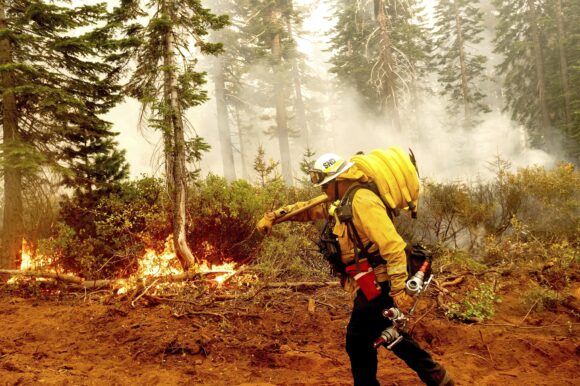While the official start to California’s wildfire season is still a ways off, the best forecast of what’s ahead may be to look back on the year so far, and so far it’s been far busier for firefighters than last year—and the state is heading into a week of triple digit temperatures and a holiday with fireworks.
“I think the way we look at the fire season is based upon several factors, but if we just look at what’s occurred this year versus last year—a 1600% increase in acres burned this year compared to last year looking at that same timeframe—if the future is any indication of what has occurred already this year, it’s going to be a challenging season for firefighters across the state,” said Nick Schuler, deputy director of communications and emergency incident awareness for CalFire.
With the year only half over, CalFire reports 2,829 wildfires and 131,483 acres burned so far. The biggest fire currently burning in the state is the Basin Fire in Fresno County. The fire has burned 12,631 acres and is 0% contained. Evacuation orders and warnings have been issued for the fire, which started on Wednesday.
A few headline-drawing wildfires have occurred across the state since June.
Residents of a California area near the town of Paradise, the site of the most destructive wildfire in state history, were ordered to evacuate and roads were closed as a wildfire spread. The Apache Fire in Palermo destroyed two structures and caused one injury. A wildfire raged through a large swath of western Sacramento Valley after igniting in mid-June and spreading to more than 15,000 acres. Evacuations were ordered in rural areas around the Sites Fire in Colusa County, which burned roughly 70 miles northwest of Sacramento. Both fires have been fully controlled.
It’s hot and going to get hotter in the state. Intense summer heat is expected to impact much of the western U.S., and an excessive heat watch is in effect from July 2 through July 6 for areas of central California.
AccuWeather meteorologists say a heat dome will send temperatures skyrocketing in central California, with “record-challenging heat” intensifying across parts of the Sacramento Valley and San Joaquin Valley by midweek. A forecast high of 115 degrees in Fresno on Saturday would tie the all-time record high from July 8, 1905.
The state’s wildfire season has continued to comer earlier, and the season follows two wet years that drove vegetation growth—increasing wildfire fuel.
“In California, we really talk about a fire year now versus a fire season because our wildfires are occurring in months that people typically aren’t used to seeing fires,” Schuler said.
Just how many properties will burn or are at risk of burning will come into focus at the season wears on. CoreLogic, a property data firm, is due to produce its annual report on wildfire risk in August. The report lists how many properties are at risk from wildfire across the U.S.
CoreLogic also conducts an analysis of wildfire hazards in metropolitan areas by calculating the residential exposure to higher categories of wildfire risk and the reconstruction cost of properties. In the April forecast, all the metro areas on the list were in the West, six of which are in California. Los Angeles topped the list with 185,763 properties at a higher risk and at a reconstruction value of $143.3 billion. The rest of the top five were Riverside (166,372 at $86.6 billion), San Diego (123,060 at $75.6 billion), Sacramento (91,475 at $53.2 billion) and San Francisco (56,985 at $40.2 billion).
Jamie Knippen, a product manager at CoreLogic, noted that the destructive potential for the wildfire season depends on frequency and severity.
“So, with these fuels growing back due to the (wet) weather seasons, there’s going to be more vegetation to potentially burn, so the frequency of those fires may increase,” Knippen said. “As for the severity, it really depends on where these things actually occur and what they actually come into contact with. If they’re up against nerve area, we’re talking about a completely different scenario than if we’re talking about in the middle of a grassland or forest.”
The fire season we used to know is gone, and it’s no longer just a season. Fires are often larger, and seasons are now longer, according to Knippen. “Meaning the number of acres that we’re going to see burn year-to-year likely will be an increase, and we’ve seen that over the last few years,” she added.
Was this article valuable?
Here are more articles you may enjoy.


 Abbott Presses Congress for Shield Over Preemie Baby Formula Litigation That Could Cost It Billions
Abbott Presses Congress for Shield Over Preemie Baby Formula Litigation That Could Cost It Billions  ‘Dream Is in Sight:’ Chamber, Reinsurers, Insurers Urge Florida to Stay the Course
‘Dream Is in Sight:’ Chamber, Reinsurers, Insurers Urge Florida to Stay the Course  Standard Chartered Settles $2 Billion Iranian Sanction Suit in London
Standard Chartered Settles $2 Billion Iranian Sanction Suit in London  Asahi Sales Drop Worsens as Cyber Hack Disruption Lingers
Asahi Sales Drop Worsens as Cyber Hack Disruption Lingers 